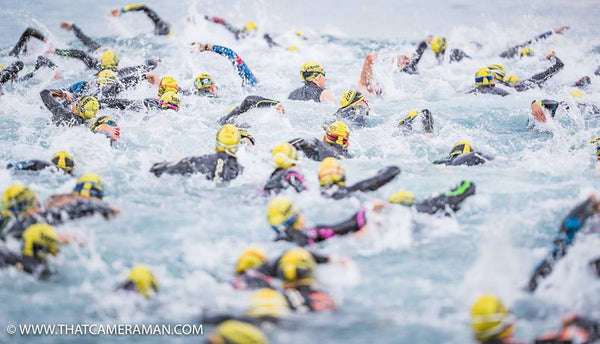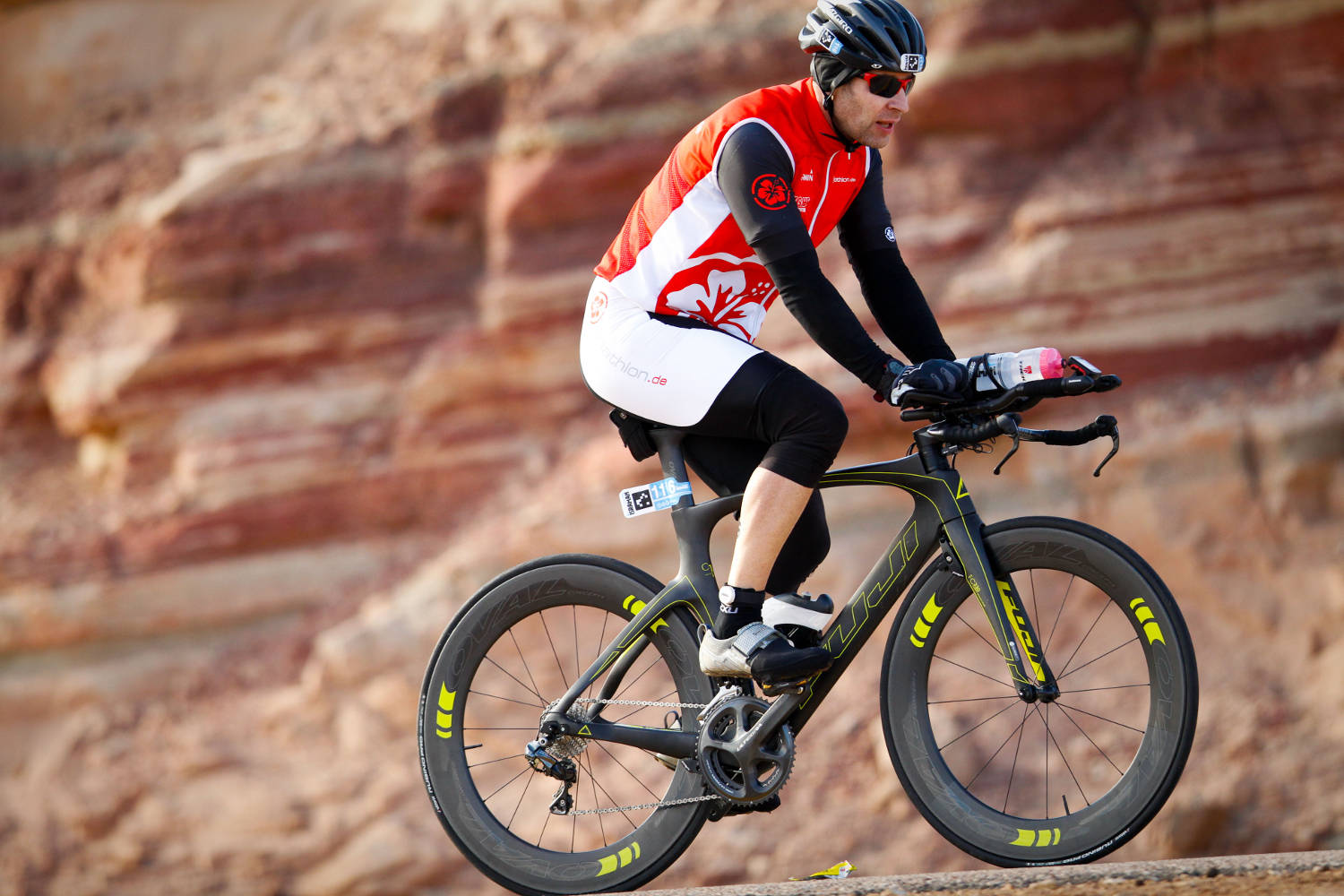
As usual, I wanted to “move everything through” the day before the race. That means I usually swim about 500 meters and cycle about 15-20 minutes and run about 15-20 minutes, if possible all in quick succession. In the individual disciplines, I usually add about 1 minute at the competition pace. That helps me to build up some excitement for the race again without "shooting myself down". This Thursday - at Israman the competition is on Friday - everything was different. Already in the morning it was continuously clouding over and in the late morning it began to rain, storm and thunderstorms. Since I still had to set up my bike, I was very late. In the thunderstorm I didn't want to drive or swim anymore. In addition, according to the schedule, the bike and the bag for transition area 2 should be checked in by 4:30 p.m. So I gave up my usual "warm-up program". However, at check-in it turned out that this had been postponed to the next morning due to the storm in order to avoid damage to the wheels. But that was the end of the day and after a long dinner, we went to bed.

race day

I set the alarm for 5:10 am. Since my hotel, the Isrotel Royal Garden , was perfectly located at the start, finish and transition area, I had short distances in the morning and was able to do everything in a relaxed manner. After a short breakfast and check-in of the bike and change bags, I went back to my room to get my wetsuit and swimming gear. From there I started straight away for the swim start and punctually at 6:37 a.m. on the swim course. The Red Sea, where swimming takes place, has a temperature of about 23 degrees all year round. That means it's also super pleasant in the morning. In addition, the water is very clear and you can see the bottom for a long time, actually always the swimmers in front of you and lots of fish. I choked once while swimming and had to realize that the salt content is also very high. You can tell by the fact that the salt water burns strongly in the mouth. Of course, the high salt content and the Neo ensure a great position in the water. I deliberately took it easy on the race because my preparation was rather modest. Everything went well, as I said, the conditions were very pleasant and I was able to swim relatively far in front of my starting group in a relaxed manner. After 31:44 minutes I came out of the water, which I was totally satisfied with. The way to the transition zone is quite long at about 400 meters. Here, too, and at the change, I took my time with 12 minutes, because it was important to me to put on enough clothes well, because I knew that the tough part was coming up.
Good preparation?
Right in the first hour on the bike, I had to pay for my poor preparation in several ways. For one thing, I hadn't particularly thought about my translation on the bike, to be honest not at all. As it turns out, a few more teeth on the cassette would have been nice on the steep climbs though. On the other hand, I noticed pretty quickly that I had neglected my stabilizers badly in the last 2 months - although I preach that to all my athletes. So I finished the first climb over about 16 kilometers with sensitive back pain in my lower back, which I unfortunately couldn't get rid of for the whole race. But more on that later.
Start climb done...not quite
If you are happy that the mountain is over at the end of the start ascent, transition zone 2, which you can only use on the way back, is greeted by a nice, chilly front wind. Words that start with "Sch..." appeared in my mind. If you also think you've done the hard part with the start climb, you'll be disabused. You have not even overcome half of the altitude difference. Roughly speaking, two longer climbs of 200 meters each and of course in each direction (back and forth) have to be overcome. In total, the route of the half-distance has about 1,800 meters in altitude. But that also means that the track is almost never flat. In addition, there are winds, which are probably favored by the rugged landscape. One of the victims of these cross winds was the Pole, who was the leader over the long distance and was unable to finish the race after a fall. In addition, it has a sensitive 5 degrees in the mountains, which makes the load even more demanding. As already described, I arrived at the top of the start climb with severe pain in my back. My lower back had cramped from the heavy strain of riding thick gears. When I got to the top, I first got down and had to stretch extensively and relax my back. That was halfway successful, so I was able to make up a lot of ground over the next 40 kilometers. I passed at least 50 other athletes and made really good progress. That was actually the nicest part of the race. As planned, I enjoyed the great landscape and I was also able to handle the strong, twisting cross winds on the descents.

Description bike course
The course passes through the southern Negev desert. One is reminded of a lunar landscape, since everything is very rugged and one sees almost no vegetation. In many places, you can see the many different colored layers of rock that have been deposited on top of each other over thousands, maybe millions of years due to erosion. A strong wind constantly sweeps across this rough landscape. On the one hand you drive along the Egyptian-Israeli border for a long time. This is marked by a sturdy fence about 4 meters high and reinforced with barbed wire. Forts and military bunkers are located at regular intervals on both sides of the border. A few fully armed Israeli soldiers are also standing by the route, more or less interested, watching the unusual goings-on from their border post. On the other hand, you can always look across the valley to Jordan. An unusual, almost unreal situation for me that as a cyclist you are mostly cheered on by soldiers who have their automatic weapons slung over their shoulders.

Mountain high with a headwind
Arrived at the turning point, it immediately went uphill again and the wind blew us in the face. My average speed on this slightly less than 2nd half of the bike course was less than 20 km/h. So I bobbed along with back pain and several stretching breaks to transition area 2. In the meantime, the 50 athletes I had easily rolled past had all overtaken me again. Now one or the other will say that Schick has moved on much too quickly. "Oh contraire," I would reply. I drove the whole time under control with a pulse in the range of around 140 beats (which is rather easy for me), I ate well on the way and if I had started too quickly, the slump should have come much earlier. Anyway, the way back was pretty painful.

What are you supposed to wear?
In transition zone 2, I briefly considered what I should take off or leave on. I wore my aero suit with arm warmers, leg warmers, wind vest and a wind blocker hat. I decided to leave everything on for now because it was really sticky at the top. And the good thing about arm warmers and leg warmers is that you can roll them down when it gets too warm. When running downhill, it took about 3km for my frozen feet to come back to life. I felt my back with every step, but since I didn't have to push downhill, it was a little better than cycling. After approx. 8 km there is an approx. 2 km long commute, which is mostly flat. Here I felt my back so much that I had to take a walk break twice. A bit further it went downhill again, but from then on the (running) oven was completely off. That is, despite several attempts, I could not run more than a maximum of 100 meters and walked so peacefully in front of me. At this point I would like to say a few words about the other, mostly Israeli participants: You could see from my start number that I am German and what my name is. It was incredible how many other athletes addressed me in a friendly and caring manner: "Are you ok", "do you need a gel", "do you want some pain killers". Likewise the many spectators on the running track. The people were really nice and kept trying to take me with them and encourage me to run. I've never experienced anything like this before. (But I've never walked that much in a triathlon either.) Everything else is history, after a half marathon of more than half hiked in 2:26 hours, I finished with a total time of 7:31 hours. That put me pretty much in the middle, i.e. 324th place out of 714 finishers.
Conclusion
Sure, I imagined it a little differently. But I'm happy for the experience and that I went through the race despite its hardships. Admittedly, I thought about giving up twice during the race. That was for the first time on the start climb and for the second time the temptation was already there at T2 to just continue on the bike and scooter to the hotel. The Israman is the most demanding middle distance that I have completed so far. It exceeded my expectations - I knew that there would be a lot of altitude difference, that it would be windy and that it could also be cold. You can't cheat or hide here. I can still feel my back and thighs three days after the race. That thing is really hard! I don't feel like I have a bill to pay now. I know that with proper preparation I can complete the race much faster if I just run the half marathon. The athletes in Israel are really active and a tight-knit community. And last but not least, my personal learning: I will never again do a race without sufficient preparation. Otherwise I'd rather not start again.
Go to the Israman homepage You want to know more about me? Then become my friend on Facebook: Ralph on Facebook
Photos: ZalemOti.com, Darren Wheeler




















